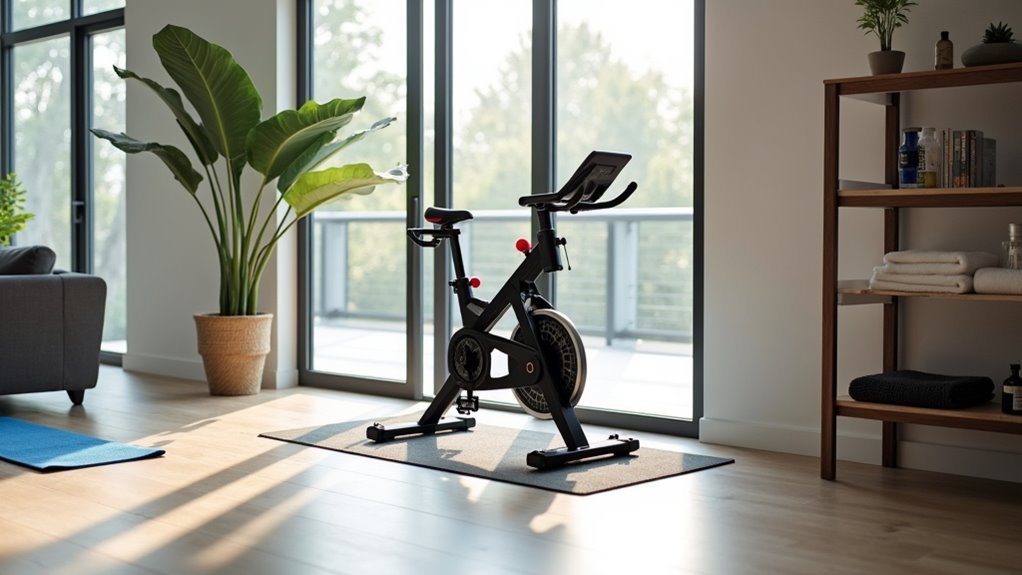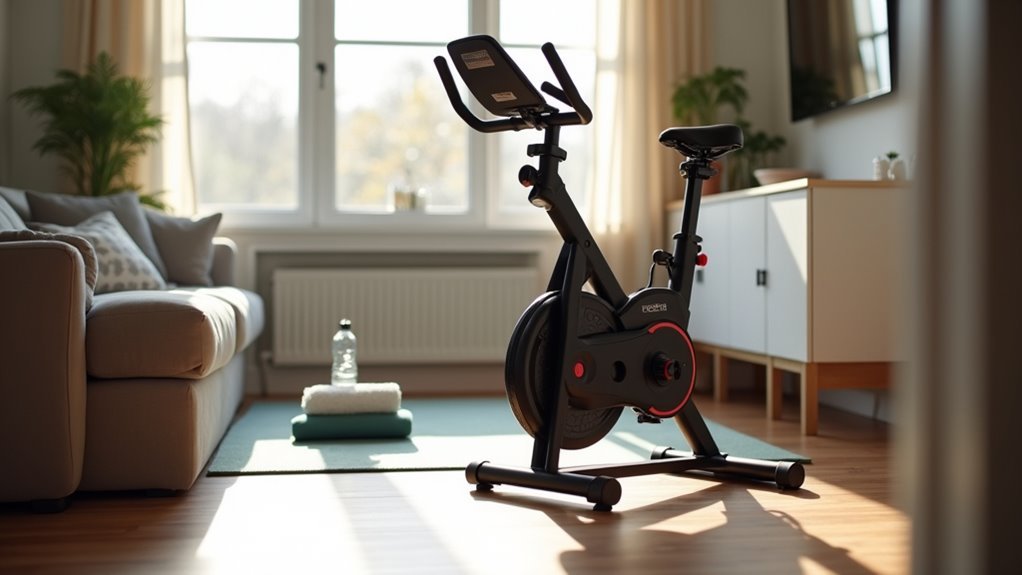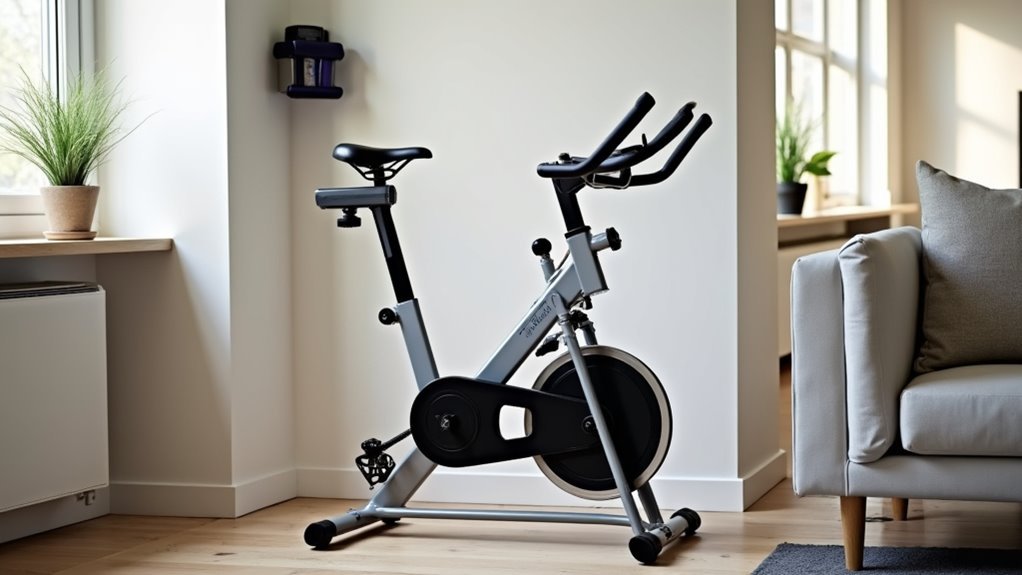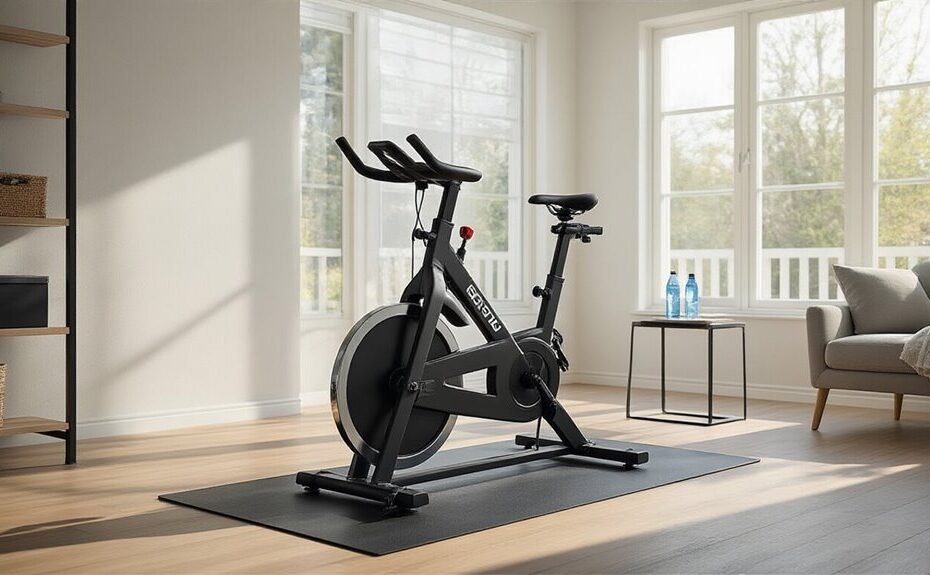Setting up an indoor exercise bike isn’t just about finding a corner to tuck it into. Many new owners don’t realize that proper spacing makes all the difference between a comfortable workout and a frustrating experience. The bike itself needs room, but what about those moments when you’re climbing on or off while tired? Or when you need to reach for a water bottle mid-interval? These practical considerations often get overlooked until it’s too late. The right setup might require more space than initially thought.
Minimum Space Requirements for Different Exercise Bike Types
When planning for an indoor exercise bike setup, adequate space allocation is perhaps the most overlooked yet essential factor for both safety and workout effectiveness.
Different bike types demand different minimum space requirements. The baseline for any exercise bike is at least 4 feet by 8 feet, with an additional 10 square feet of clearance space recommended around the equipment.
Recumbent bikes generally need more room than upright models due to their larger footprint.
The Keiser M3i and similar indoor cycling bikes must accommodate users of varying heights, so placement becomes even more significant.
Don’t forget to take into account ventilation space—you’ll definitely heat up during those intense sessions! Additionally, consider that smart bikes offer live classes, enhancing your home workout experience.
Measuring Your Available Area for an Indoor Cycling Setup
Now that you understand the space requirements for different bike types, proper measurement of your available area becomes the next logical step. When planning your indoor training space, you’ll need to measure both the footprint needed and clearance zones.
| Measurement | Minimum Needed | Ideal Setup | Purpose |
|---|---|---|---|
| Floor Space | 4′ x 8′ | 6′ x 10′ | Basic bike fit |
| Clearance | 10 sq ft | 20+ sq ft | Safe movement |
| Ceiling Height | 7′ | 8’+ | Proper riding position |
| Outlet Distance | Within 6′ | Multiple outlets | Power for equipment |
Don’t forget to check ventilation too—nobody wants to struggle through a workout in a stuffy room! Additionally, ensuring enough space for safe movement around your bike allows for better engagement in indoor cycling, which can enhance your overall fitness experience.
Clearance Zones for Safe and Comfortable Workouts

When setting up an indoor exercise bike, proper clearance zones are essential for both safety and workout effectiveness.
Experts recommend maintaining at least 10 square feet of open space around your bike, with particular attention to front and back clearance for mounting and dismounting.
Side-to-side movement zones shouldn’t be overlooked either, as they provide necessary room for natural body movements during intense cycling sessions and prevent accidents from occurring.
Minimum Clearance Requirements
Creating a comfortable workout zone for your indoor exercise bike requires thoughtful planning around space requirements.
Experts recommend a minimum clearance of 4 feet by 8 feet for your indoor exercise bike setup—that’s about 32 square feet at minimum. You’ll also want at least 10 square feet of open space surrounding the equipment for safety during intense sessions.
The workout area should have access to electrical outlets for fans or smart trainers.
Avoid cramming your bike into tight spaces like bathrooms or closets, which can actually discourage consistent use. Larger, open areas provide better airflow, which you’ll definitely appreciate during sweaty rides.
Front/Back Space Considerations
Beyond adequate floor space, proper front and back clearance zones for exercise bikes are essential to maintaining both safety and comfort during your workouts.
Exercise bikes require at least 2 feet of clearance in both front and back directions to allow for safe mounting, dismounting, and natural movement while pedaling.
The front clearance guarantees you can easily access the handlebars without feeling cramped, while the back space accommodates any backward shifts that might occur during intense sessions.
Think of these clearance spaces as your workout bubble – they’re not just empty space, they’re actually part of your exercise zone that protects you from potential injuries.
Side-to-Side Movement Zones
Just as important as front-to-back clearance, side-to-side movement zones provide critical space for stability and natural body positioning during indoor cycling workouts.
Experts recommend maintaining at least 10 square feet of clearance space around your exercise bike.
When cycling, your body naturally shifts laterally as you pedal, especially during intense sessions.
Without adequate room for these side-to-side movements, you might bump into walls or furniture, compromising your workout experience and potentially causing injury.
The minimum recommended area is 4 feet by 8 feet, but honestly, a bit more space is always better.
You’ll appreciate that extra room when you’re really pushing yourself!
Space-Saving Exercise Bike Models for Small Apartments

Living in a small apartment often requires thoughtful consideration of every square foot, and exercise equipment traditionally hasn’t been known for its space efficiency.
Fortunately, manufacturers have responded with space-saving exercise bike models specifically designed for compact living spaces.
The LifeSpan C5i exemplifies this trend with its modest 40.5″ L x 28″ W footprint, while the Fit Spin Pro Magnetic offers a realistic cycling experience without dominating the room.
For ultimate flexibility, foldable bikes can be tucked away when not in use. The Keiser M3i’s vertical design is another smart solution for tight quarters. Recumbent bikes are ideal for low-impact cardio and can provide comfortable workouts even in small spaces.
Just remember—you’ll still need about 10 square feet for safe, comfortable workouts.
Optimal Room Placement and Layout Considerations
While finding the perfect exercise bike is essential, determining where to place it in your home is equally important for creating an effective workout environment.
The minimum space needed is 4 feet by 8 feet, with a 10 square foot clearance space around the bike for safety and comfort.
For ideal placement, consider:
- Rooms with good ventilation to prevent overheating during intense workouts
- Areas near electrical outlets for powering fans or charging devices
- Well-lit spaces that aren’t confined (like bathrooms or closets)
Larger, open areas not only provide better airflow but also create a more motivating atmosphere for your cycling sessions. Additionally, selecting a bike type that caters to your individual needs can greatly enhance your overall workout experience, especially when considering different fitness goals.
Storage Solutions for Foldable and Portable Exercise Bikes

After establishing the perfect spot for your exercise bike, many home fitness enthusiasts face the challenge of what to do with the equipment when it’s not in use.
Foldable and portable exercise bikes are game-changers, requiring just 2-3 square feet when collapsed. To maximize storage efficiency, look for models that stand upright when folded.
Most portable exercise bikes come with built-in wheels – pretty handy for moving them into closets or sliding under beds.
It’s best to store them in dry areas, though. You know what moisture can do to those components!
Wall hooks or dedicated bike stands can also free up floor space, keeping your storage solutions organized and your workout area clutter-free.
Additional Space Needs for Accessories and Maintenance
When setting up an indoor cycling space, you’ll need more room than just what the bike occupies.
Smart cyclists allocate at least an extra 10 square feet for accessories like fans, mats, and maintenance equipment that enhance the workout experience.
It’s also essential to take into account proximity to electrical outlets and proper ventilation to create a functional training environment that supports both riding comfort and proper bike maintenance.
Essential Accessories Space
Setting up your indoor exercise bike requires more than just space for the equipment itself.
Planning for essential accessories guarantees a comfortable and effective workout experience. The area around your indoor exercise bike should include at least 4′ × 8′ of additional space to accommodate everything you’ll need.
- A waterproof mat underneath the bike protects your floor and provides space for absorbent towels
- Room for at least one stationary fan to improve airflow and keep you cool during intense sessions
- A dedicated area for maintenance supplies and hydration that’s within arm’s reach
Maintenance Area Requirements
Beyond the basic setup, a dedicated maintenance area near your exercise bike proves invaluable for its longevity and your workout efficiency.
This space should house essential cleaning supplies, lubricants, and tools needed for regular upkeep of your exercise equipment. Smart trainers especially benefit from organized maintenance zones where replacement parts and trainer-specific tires can be stored.
Ideally, allocate a small utility cart or bin within easy reach—you’ll thank yourself after sweaty sessions when wiping down is the last thing you want to complicate.
Well-organized maintenance areas don’t need to be huge, but they should be accessible enough to encourage regular equipment care.
Frequently Asked Questions
How Much Room Do You Need for an Exercise Bike?
Exercise bike dimensions require a minimum 4×8 foot space for the equipment itself. Ideal workout space should include 10 square feet of clearance around the bike for safe placement tips.
Can I Lose Belly Fat by Riding a Stationary Bike?
Will stationary biking melt away stubborn belly fat? Yes, it can effectively reduce belly fat through consistent calorie burn. Higher workout intensity accelerates results, especially when combined with proper nutrition.
What Is the N-1 Rule for Bikes?
The N-1 rule suggests owning one less bike than household members, allowing efficient space usage while ensuring proper bike sizing, diverse workout intensity options, and comfortable pedal stroke for all users.
Is 30 Minutes of Stationary Bike the Same as 30 Minutes of Walking?
While some might assume they’re equivalent, 30 minutes of stationary biking isn’t the same as walking. Biking offers higher workout intensity and calorie comparison favors cycling, while walking has greater joint impact.
